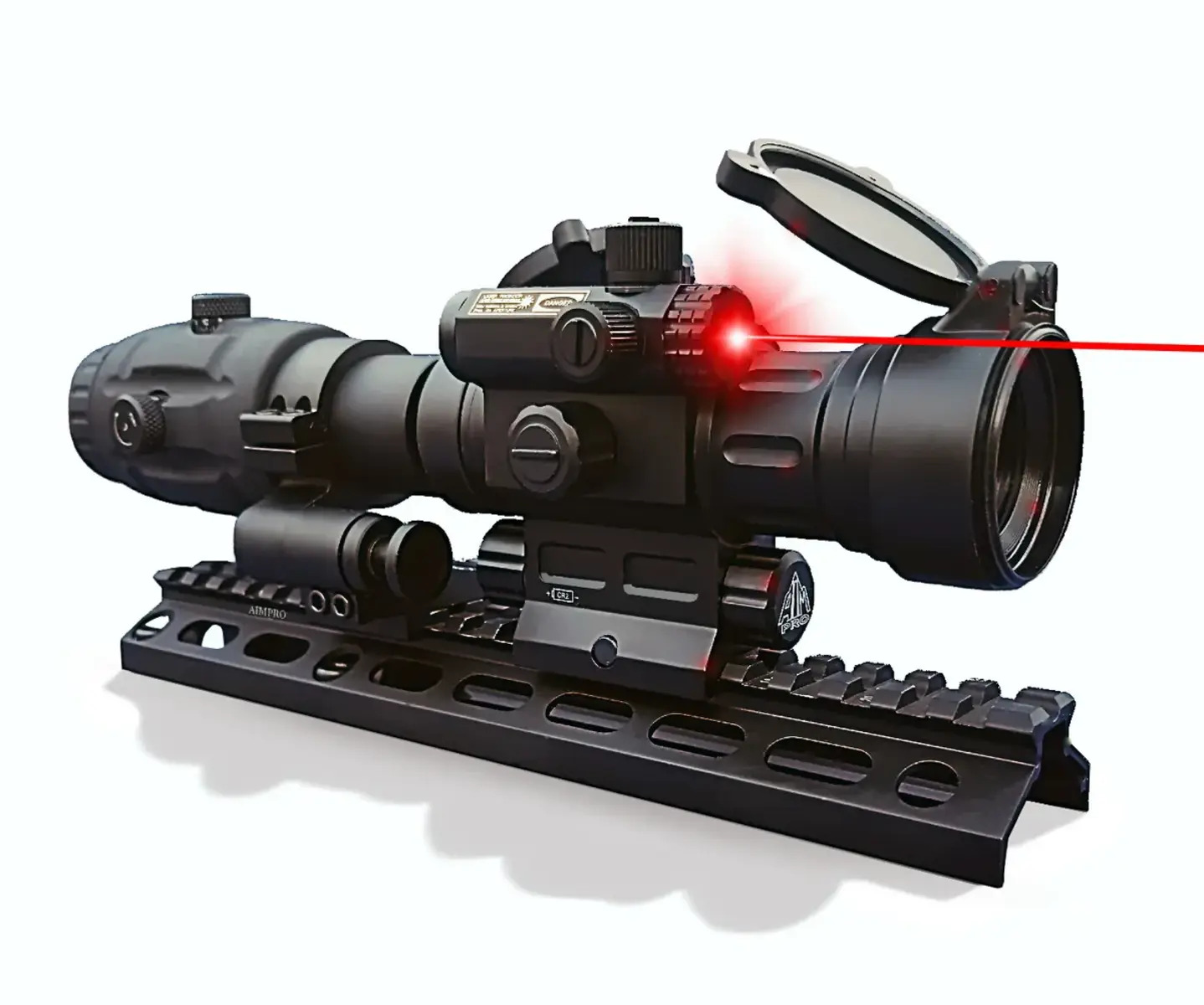What is a Reflex Sight?
A reflex sight, also known as a red dot sight, is a popular type of firearm sight that provides the shooter with a simple and effective aiming solution. Unlike traditional iron sights, a reflex sight uses a red dot or reticle projected onto a specially coated lens to assist the shooter in aiming at the target. The red dot is superimposed onto the target, allowing for quick and accurate aiming, especially in scenarios where rapid target acquisition is crucial.
One of the main advantages of a reflex sight is its ability to provide a clear and unobstructed view of the target, as the shooter does not need to align rear and front sights to aim accurately. This feature makes reflex sights particularly useful in dynamic shooting situations, such as competitive shooting, hunting, and tactical applications where speed and precision are essential.
Reflex sights are available in various configurations, including open and tube-style designs, and they can be equipped with different reticle patterns, such as dot, circle-dot, or crosshair, to accommodate individual preferences and shooting requirements. Additionally, many modern reflex sights are designed to be parallax-free, meaning that the point of aim remains consistent regardless of the shooter’s eye position, further enhancing accuracy and ease of use.
What is a Magnifier and How Does it Work?
A magnifier is an optical accessory designed to enhance the magnification of a red dot or reflex sight, allowing for improved target identification and engagement at extended ranges. Typically mounted behind the reflex sight, the magnifier works in conjunction with the sight to provide shooters with the versatility of both close-quarters engagement and precise long-range shooting.
Utilizing a magnifier involves a simple yet effective principle of optics. Most magnifiers feature a fixed or adjustable magnification level, commonly ranging from 3X to 5X, which effectively magnifies the image seen through the reflex sight. The magnifier incorporates a multi-coated lens system that preserves the clarity and brightness of the red dot reticle, ensuring that the aiming point remains crisp and visible even at higher magnification levels.
When a shooter looks through the magnifier, the red dot reticle from the reflex sight is magnified along with the target, providing an enlarged and more detailed view. This enhanced magnification facilitates precise shot placement and target discrimination at longer distances, making the combination of a reflex sight and magnifier a versatile solution for engaging targets across varying ranges.
Moreover, many magnifiers are designed with a flip-to-side mount, allowing the shooter to swiftly move the magnifier to the side when close-quarters engagement is required, effectively returning to the unmagnified reflex sight for rapid target acquisition. This seamless transition between magnified and non-magnified aiming solutions adds a layer of adaptability to the shooter’s setup, catering to diverse shooting scenarios without the need for complex adjustments or sight changes.
Reflex Sight Compatibility with Magnifiers
When considering the compatibility of a reflex sight with a magnifier, it is essential to ensure that the two components are designed to work together seamlessly. Many modern reflex sights are explicitly engineered to accommodate magnifiers, featuring a standardized mounting interface that allows for straightforward attachment and alignment of the magnifier behind the sight.
Compatibility between a reflex sight and magnifier is primarily determined by the mounting system employed by both accessories. Most magnifiers utilize a flip-to-side mount, which enables quick and effortless transition between magnified and non-magnified aiming. This mount typically interfaces with a Picatinny or Weaver rail, ensuring a secure and stable attachment to the firearm.
Moreover, reflex sights that are magnifier-compatible often incorporate a short eye relief and a generous field of view to facilitate comfortable and unrestricted use of the magnifier. The eye relief refers to the distance between the shooter’s eye and the rear lens of the reflex sight, and a shorter eye relief allows for optimal positioning of the magnifier without compromising the shooter’s comfort or sight picture.
Additionally, the design of the reflex sight’s housing and adjustment controls should complement the use of a magnifier, allowing for unobstructed mounting and operation. The overall dimensions and profile of the reflex sight should permit the installation of a magnifier without interfering with the sight’s functionality or impeding the shooter’s ability to manipulate the controls or access the magnifier’s flip-to-side mechanism.
Furthermore, the compatibility of a reflex sight with a magnifier extends to the optical performance and alignment of the two components. A well-matched combination ensures that the red dot reticle remains crisp and consistent when viewed through the magnifier, preserving the sight’s aiming precision and eliminating any distortion or parallax issues that may arise from the magnification process.
Ultimately, ensuring compatibility between a reflex sight and magnifier involves selecting components that are specifically designed to complement each other, offering a harmonious integration that enhances the shooter’s capabilities and versatility in various shooting scenarios.
Factors to Consider When Using a Magnifier with a Reflex Sight
Integrating a magnifier with a reflex sight introduces several important considerations that can significantly impact the overall performance and usability of the combined system. Understanding these factors is crucial for shooters seeking to optimize the functionality and effectiveness of their magnified reflex sight setup.
- Magnification Level: Selecting the appropriate magnification level for the magnifier is essential. The chosen magnification should align with the shooter’s intended application and engagement distances. Higher magnification levels offer enhanced target identification and precision at longer ranges, while lower magnification levels may be more suitable for close-quarters shooting scenarios.
- Eye Relief and Comfort: Ensuring adequate eye relief and comfortable eye positioning when using the magnifier is vital for maintaining a clear sight picture and minimizing eye strain during prolonged use. Proper eye relief allows the shooter to maintain a consistent and comfortable shooting posture while utilizing the magnified reflex sight.
- Mounting Compatibility: Verifying the compatibility of the magnifier’s mounting system with the reflex sight is crucial. Both components should seamlessly integrate without obstructing the reflex sight’s operation or impeding the shooter’s ability to transition between magnified and non-magnified aiming solutions.
- Optical Quality: Assessing the optical quality of the magnifier is essential for ensuring that the red dot reticle remains sharp, clear, and distortion-free when viewed through the magnifier. High-quality optics preserve the aiming precision and consistency of the reflex sight, contributing to accurate target engagement.
- Field of View: Considering the field of view provided by the magnifier is important, as it directly influences the shooter’s situational awareness and ability to track targets. A generous field of view facilitates rapid target acquisition and tracking, especially in dynamic shooting environments.
- Flip-to-Side Mechanism: Evaluating the effectiveness and reliability of the magnifier’s flip-to-side mount is crucial for seamless transition between magnified and non-magnified aiming. A robust and user-friendly flip-to-side mechanism enhances the versatility and adaptability of the magnified reflex sight setup.
By carefully considering these factors and selecting a magnifier that aligns with the specific requirements of the shooter and the intended shooting scenarios, the integration of a magnifier with a reflex sight can significantly enhance the shooter’s capabilities and precision, offering a flexible and adaptable aiming solution for diverse shooting applications.
Tips for Choosing the Right Magnifier for Your Reflex Sight
When selecting a magnifier to complement your reflex sight, several key considerations can guide you toward choosing the most suitable and effective magnification solution for your shooting needs.
- Compatibility: Ensure that the magnifier is specifically designed for use with reflex sights and offers seamless integration with your particular reflex sight model. Compatibility encompasses mounting interface, optical alignment, and overall ergonomic suitability for combined use.
- Magnification Level: Consider the intended shooting distances and scenarios to determine the optimal magnification level for your magnifier. Balancing magnification power with versatility is crucial, as excessively high magnification may limit close-quarters effectiveness, while lower magnification may compromise long-range precision.
- Optical Quality: Prioritize magnifiers with high-quality optics, multi-coated lenses, and superior light transmission to ensure a clear, distortion-free view of the red dot reticle and the target. Optimal optical performance preserves aiming precision and enhances target identification.
- Mounting System: Assess the mounting system of the magnifier, ensuring compatibility with your reflex sight’s mounting configuration. A robust and reliable mounting interface, such as a flip-to-side mount with secure locking mechanisms, facilitates quick transitions between magnified and non-magnified aiming without compromising stability.
- Eye Relief and Comfort: Prioritize magnifiers with adequate eye relief and ergonomic design to promote comfortable and consistent eye positioning during extended use. Comfortable eye relief minimizes eye strain and facilitates a natural shooting posture when utilizing the magnified reflex sight.
- Field of View: Consider the field of view provided by the magnifier, as a generous field of view enhances situational awareness and target tracking. An ample field of view contributes to rapid target acquisition and engagement, particularly in dynamic shooting environments.
- Durability and Reliability: Select a magnifier constructed from durable materials, featuring robust construction and weather-resistant properties to withstand rigorous shooting conditions. A reliable magnifier ensures consistent performance and functionality in diverse environments.
- User Feedback and Reviews: Research and consider user feedback, reviews, and testimonials regarding the performance, reliability, and user experience of the magnifier. Real-world experiences and insights from fellow shooters can provide valuable guidance in the selection process.
By carefully evaluating these tips and considering the specific shooting requirements, preferences, and equipment compatibility, shooters can make informed decisions when choosing a magnifier that seamlessly integrates with their reflex sight, enhancing their shooting capabilities and versatility across varying engagement distances and scenarios.


